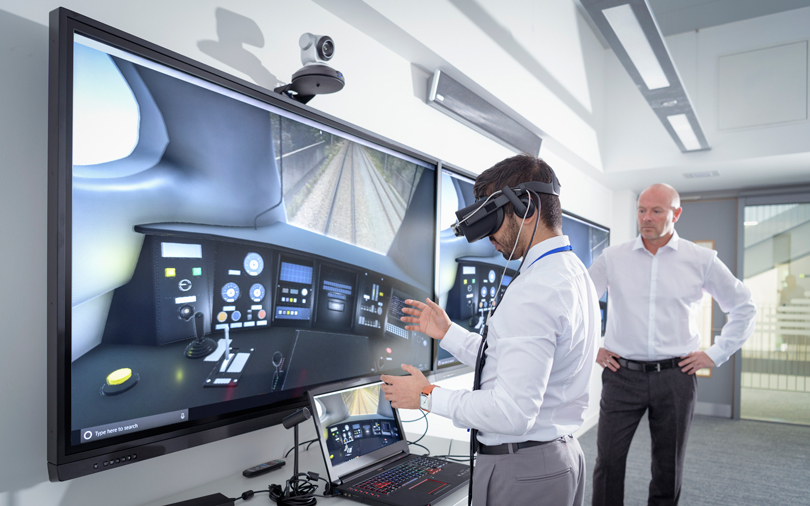Railway industry

The main task of the railway industry is to provide passenger and freight transportation.
The organization of the transportation process at a railway station or network, the management of locomotives, monitoring the power supply system, diagnosing the condition of the track, are complex tasks that require thorough theoretical and practical professional training of personnel.
The use of virtual reality simulators in the training of specialists in the railway industry makes it possible to increase the efficiency and safety of the transportation process, and reduce personnel injuries in the workplace.
The main tasks that virtual reality solves in the training of employees of the railway industry:
training in the operation of equipment, analysis of technical condition and testing;
preparation for railway train management, skills development;
instruction on the rules of safe behavior at the workplace in standard conditions and emergency situations.
The VR simulator creates the illusion of being present in the working environment and controlling the process through visual and sound effects.
By design and purpose, VR simulators can be divided into:
simulators that simulate the device and functions of locomotives. They are intended for working out techniques, methods of maintenance and
managing real objects;
simulators designed for the formation of intellectual work skills. These include, for example, simulators that demonstrate the malfunction of equipment and equipment and are intended for training in troubleshooting; simulators for training adjusters of automatic machines and automatic lines, searching for the causes of defects;
training devices designed to form a motor (motor) skill.
Advantages of using VR simulators in comparison with traditional training:
modeling real situations in virtual reality allows you to better assimilate information;
development of practical skills in a safe environment;
the employee becomes an active participant in the process and performs a real technological operation;
formation of » muscle memory;
the ability to evaluate the performance of technological operations at all stages.
The entire learning process with virtual reality simulators is interactive. The trainee sees a plausible animation of the equipment operation, monitors the readings of virtual devices in real time and receives feedback modeled by the simulator. In the event of a violation of safety regulations or the commission of incorrect actions during training, the employee experiences consequences in the form of a noise or light effect: an imitation of an electric shock, explosion, fire. The employee receives an emotional» shake-up » and has the opportunity to visually assess the critical result of the actions performed. All training results are saved by the program and can be used in the future to work on mistakes and improve skills.
The main causes of industrial injuries in the railway industry, experts say, are unsatisfactory organization of work, lack of control over the implementation of technology, non-compliance with labor and production discipline. Most cases with a serious and fatal outcome are associated with the human factor, which can be overcome by improving the system of employee training.
How do VR simulators work?
The development of each simulator begins with the creation of a realistic environment, or location: a railway station, sections of track with rails, warehouses or other objects corresponding to the declared product theme. Equipped with a unique user interface with a detailed description of details, tools and the ability to switch between tasks, as well as sound accompaniment create a unique space for effective learning.
Virtual reality simulators can be used for individual and group training. The program records the shortcomings of each employee and allows instructors and management to see the analysis of personal skills and achievements of employees.
Virtual training of employees on assembly/disassembly, repair and maintenance of complex equipment, as well as working out skills in the field of labor protection and industrial safety can reduce production costs by 30% and reduce the number of employee errors and equipment downtime.
What virtual reality simulators are already used?
The virtual reality simulator for training electricians of the contact network makes it possible to work out the technology of installing and removing grounding rods when working with voltage relief on the AC contact network, hone skills in preparing the workplace and using a protective suit against the effects of induced voltage.
There are VR simulators that allow ecsebists to perform an operation to replace the electric switch drive, track workers-to correct drawdowns and distortions of the track on the crushed stone ballast by lining sleepers with electric sleepers, locomotive crews-to study the procedure for actions in case of an electric train fire.

